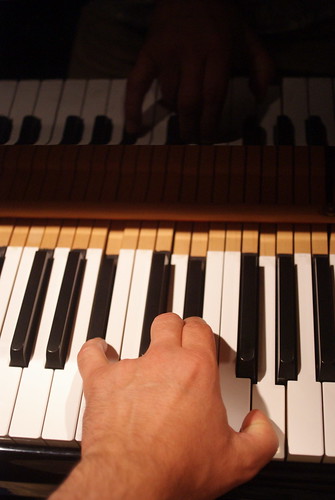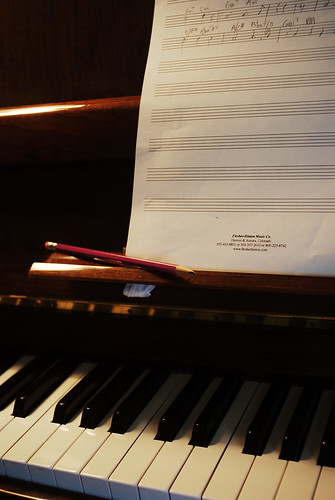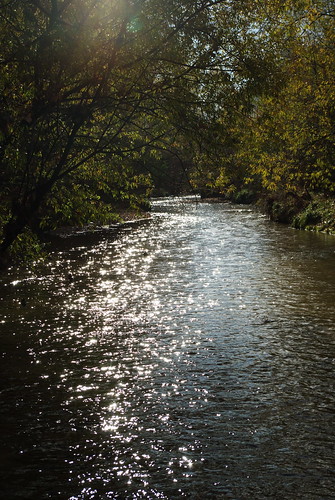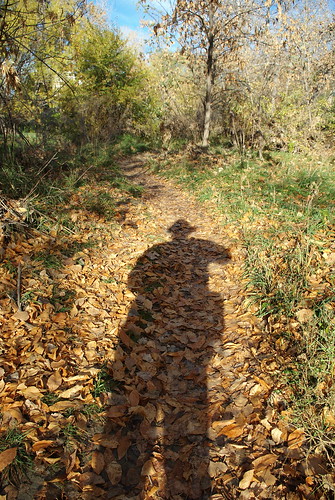Light

Let me start by telling you what kind of advice you won't get here: advice on using flash. That's for a different blog, one perhaps entitled "how to annoy musicians and fellow listeners while ending up with pictures that fail to capture the original mood of the event". OK, that's a little harsh - flash can be effective and useful for certain effects and in certain settings, but it's just not what I do.
Instead, we're going to be talking about available light photography. For outdoor concerts, life is pretty simple, but not so for indoor concerts. While the lights on stage may seem bright in comparison to the dark of the club or hall, they usually aren't very bright by photographic standards. So we're talking about low light photography. This means shooting at relatively high sensitivity (eg, ISO 400, 800, 1600, or even higher) in order to get shutter speeds fast enough to avoid blur. Many of the techniques we'll talk about involve dealing with these issues.
Camera
Now, it is certainly possible to shoot concerts with film cameras, and obviously, people have been doing this for much longer than they have with digital. Most of the advice I give will be similar between film and digital, but I will be focusing on digital, since that is where most of my experience is. In general, you're best off with a digital single lens reflex (DSLR), as they are able to shoot at higher ISO values with lower noise (graininess). So the rest of my comments assume you are using a DSLR. As of this writing, I use a Pentax K200D, which has more than adequate noise performance, even when forced to underexpose at ISO 1600, as is often the case. It also has built-in stabilization, which allows me to shoot at lower shutter speeds than I otherwise might. Stabilization is discussed further below - in the section on lenses - because on other camera systems, stabilization is a function of the lens, not the camera.
Of course, some "point and shoot" (P&S) cameras are also capable of good results if you know how to use them to their best advantage. The controls are often different, but if you understand how they work, you may be able to make use of much of the advice I will give on using a DSLR. And even though you cannot change lenses as you can with a DSLR, the discussion on lenses below might be useful in choosing a P&S camera, as you not only want good high ISO performance, but also a lens that will do the job for you, since you won't be able to change lenses later.
Your camera will need to provide manual exposure controls of some kind. I prefer the fully manual "M" mode, but creative use of exposure lock, exposure compensation, and other controls in an autoexposure mode can be just as effective.
Lens
There are two critical factors in considering lenses for concert photography: focal length and maximum aperture. Aperture is easy: basically, you want the biggest maximum aperture (ie, the lowest f-number) you can afford for the focal lengths at which you will be shooting. That is because larger apertures translate into faster shutter speeds, and in low light, we are constantly struggling to get fast enough shutter speeds to combat both camera shake and subject motion. Indeed, lenses with large maximum apertures are often called "fast" lenses, because they allow fast shutter speeds. "Slow" lenses with a maximum aperture slower than f/4 are essentially useless, and you really want f/2.8. You might think that f/2 is even better, and sometimes it is, but not only do lenses get more expensive as the maximum aperture increases, but they also get bigger and heavier, and for telephoto lenses, this can be a very significant factor. Also, f/2 is not always practical for concert photography because the depth of field is so small - it can be impossible to get a musician and his or her instrument to both be in focus. So f/2.8 is kind of a standard maximum aperture to shoot for. The f/2 lenses are more of a special luxury except at certain focal lengths like 50mm where you can get relatively small and inexpensive f/2 lenses quite easily.
Focal length is the more difficult consideration in choosing lenses, as this is more subjective, and it probably is not the case that one focal length will suffice. Most photographers these days are accustomed to using zoom lenses, which provide a range of focal lengths, so to some extent, the decision is easier than if you had to choose a single focal length. The advantage of a zoom, of course, is being able to take both wider angle shots and more close-up shots - and everything in between - from the same location. The downside is that f/2.8 zooms tend to be fairly expensive as well as large and heavy. Zooms faster than f/2.8 are practically non-existent, and they are even more expensive, large, and heavy if/when you do find one. So prime lenses - ones with a single focal length - still have their places.

As is the case with the guitar player here, many of my concert photographs are basically head-and-shoulder or upper body portraits with instruments. These are the sorts of images musicians like to use as "action shots" in their promotional materials. I suppose I gravitate to these because I am a musician myself. And as you have probably gathered my now, my main interest is jazz, so I am dealing with clubs rather than auditoriums. I tend to shoot from a table in the front at a club when possible, so I am usually only a few meters away from my subjects.
To get these kinds of shots at these kinds of distances, a focal length of around 100mm is just about perfect. My most used lens is the manual focus Pentax-M 100 f/2.8, henceforth referred to as the M100/2.8. This is what I used for the guitar player at left, for example. Note that my camera has a 1.5X "crop factor", meaning that 100mm is the equivalent of a 150mm lens in terms of what would produce the same field of view on 35mm film. Most DSLR's are similar in this respect, but be sure to know the equivalent crop factor for your own camera if comparing focal lengths to mine.
If I cannot get close to the front in a club, or if I am in a larger auditorium and have to shoot from further back, I will use a longer lens, but the further back I am, the lower the expectations I have regarding the results. I have a manual focus 135mm lens (maximum aperture f/3.5) that works well for me when I am not in the very front, and a manual focus 200mm f/4 lens that I will use on rare occasions when I know I will be really far back but still want to try to take pictures. I have also used a 135mm lens with a 1.4X teleconverter to yield the equivalent of a 200mm lens that is one f-stop slower, but I'm not sure this does better than simply cropping the image from my 135mm lens without a TC. In some larger auditoriums I have even used a basic cheap 50-200mm zoom lens with a maximum aperture of only f/5.6 at the long end. The good news is that stages in large auditoriums also tend to be better lit than in small clubs, so f/5.6 might be fast enough. This is also the lens I used most for outdoor concerts during the day.
Here are some samples to show how these focal lengths work. First, another shot from the front row with the M100/2.8:

And this one from just a little further back with the M135/3.5:

This one was in a larger auditorium where I was perhaps 20 rows back. The stage was lit well enough that was able to use the DA50-200/4-5.6 zoom at 200mm and f/5.6:

There are 70-200/2.8 zooms available for most camera brands, and these are quite popular for concert photography. This focal length range worked well for 35mm film, but on cameras with a "cropped" sensor, I find these lenses unnecessarily large, heavy, and expensive (the better part of $1000, and that's without stabilization). Pictured here is a Nikon version:

If you're serious enough about concert photography to consider buying such a lens, you are probably serious enough to go out of your way to position yourself close to the action so that you don't actually need the 200mm end very much. In situations - like sitting 20 rows back in a large auditorium - where you might you feel the need for 200mm and f/2.8, you'll probably find a 70-200/2.8 too large to deal with if there are other people sitting next to and in front of you. On the other hand, if you're at an outdoor concert during the day, you might want 200mm, but wouldn't need f/2.8.
The upshot of this is, I think most people are better off with lenses a bit shorter than 70-200mm as their main concert lenses. A 50-135/2.8 or 50-150/2.8 zoom is not necessarily much cheaper than a 70-200/2.8, but they can be significantly smaller, lighter, and easier to handle, and I think these are more useful focal length ranges for concert photography on a camera with a 1.5X crop factor.
Still, even a 50-135/2.8 lens is over twice the length and three times the weight of my M100/2.8. In fact, the M100/2.8 is even smaller than the cheap 18-55mm zoom lenses that most DSLR's are packaged with. Lens size and weight may not matter to everyone, but smaller lenses do help me feel less self-conscious about taking pictures from the audience, and they make the camera easier for me to handhold. Throw in the fact that one can buy an M100/2.8 for under $100 and you can see why I recommend it so highly for Pentax users. But I am not sure if anything comparable exists for other brands. I think Canon and Nikon owners would do well to look at the 70mm, 90mm, 100mm, or 105mm f/2.8 macro lenses, or the 85/1.8 or 100/2 lenses, that are available for these systems.
But at around $400 for a single focal length, these are getting expensive enough that many folks may decide that a more versatile 50-135/2.8 or 50-150/2.8 is worth the extra money to cover their telephoto concert needs. Certainly if I were a full-time professional, the lens would pay for itself easily, and I would appreciate the flexibility if I were under pressure to get a certain number and range of pictures. With primes, sticking to one focal length is a little limiting, but changing lenses often can be a hassle. For my purposes, a couple of primes that I change only occasionally meets my needs.
Of course, if you're looking to capture full body shots, or wish to include more than one musician in the picture, you'll need a correspondingly shorter focal length. In that case, something like a 50-135/2.8 zoom can make more sense than a longer prime. Or, you can do as I do, and bring a shorter focal length prime as well. I usually bring my DA40/2.8 "pancake" (which takes virtually no space in my bag and runs only a little over $200), although sometimes I will instead bring my manual focus A50/1.7 (also quite small, and well under $100) if I feel I might need something faster than f/2.8. I also have a DA70/2.4 to give me yet more options. But I rarely take more than two of these lenses with me, I decide based on the venue which two to take.
The 50mm focal length is worthy of special mention if for no other reason than the fact that this is usually the first "fast" lens people buy - often as fast as f/1.4. While 50mm is shorter than I usually prefer, you can always crop the results to resemble those from a longer lens. And 50mm can be an interesting focal length in itself:

However, 50mm or even 40mm on a "crop factor" camera is not usually wide enough for shots of a whole stage. For that, depending on the size of the stage and how close you are, you might need 28mm, 18mm, or even shorter. If you move back from the front row, then you don't need such a wide angle lens, but then you usually find the people in front of you end up in the photo, too, which you may not want. I normally have my M28/2.8 (under $50) with me, although I rarely use it for concert photos, because I normally prefer taking more closeup pictures. But here is an especially small stage where 28mm was just barely wide enough to fit all four musicians in:

For people who take many shots like this and are not as interested in getting as close as a 100mm lens would allow, a 28-70mm, 28-75mm, or 24-70mm f/2.8 zoom lens can make for a nice compromise. With these, you can capture both semi-wide angle shots like above as well as semi-closeup shots, and these lenses are not terribly large or terribly expensive ($400) considering their versatility. While 70mm is not really as long as I would like, it's still enough to isolate individual performers and show them in some detail. You can certainly do quite well with such a lens.
Of course, no one is limiting you to just one lens. A 28-70/2.8 plus a 105/2.8 macro and perhaps a very inexpensive 50/1.8 would cover your needs better than a 70-200/2.8 for roughly the same price. For the record, I usually have three lenses with me: either the M100/2.8 or M135/3.5, either the DA40/2.8 or A50/1.7, and the M28/2.8. I rarely feel constrained in any way with these.
There are two other considerations worth mentioning here in choosing lenses.
One is focus. Pentax users are in the enviable position of having access to a great many used manual focus lenses that work just fine on our cameras. My M100/2.8, A50/1.7, and M28/2.8 lenses cost me around $200 combined. Auto focus is often slow and/or unreliable in low light, and it is also easily confused by the instruments, microphones, standards, and other paraphernalia on stage. So if you can save money by going with used manual focus lenses, that is worth thinking about.
The other consideration is stabilization. Dealing with the slow shutter speeds we are often faced with in concert photography, stabilization can be a very useful thing. With some camera systems, stabilization can be built into the lens. Although it costs more for a stabilized version of a lens versus an ordinary one, it can be worthwhile. At a focal length of 100mm and a shutter speed of 1/30", stabilization can make the difference between having most of your shots come out acceptably sharp and most of them ruined by camera shake. Here, Pentax users have the advantage of having stabilization built in to the camera, meaning that all of our lenses - even a used manual lens you find for $20 in a pawn shop - end up being stabilized. On the downside, lens-based stabilization is generally claimed to be somewhat more effective.
Still, any stabilization is far better than none, so I think in-body stabilization is more practical for most people. Both Canon and Nikon make stabilized 70-200/2.8 lenses, which may be one reason these are popular with professional concert photographers despite being quite expensive (around $1500) and longer than usually necessary for most people. But realistically, most beginning Canon and Nikon concert photographers will probably have to pass on the benefits of stabilization for concert photography, as only the slower lenses are available in stabilized form at an affordable price. And while stabilization allows you to take shake-free photos at slower shutter speeds than you would otherwise, slow lenses won't allow fast enough shutter speeds to freeze subject motion.
Other Equipment
Aside from the obvious - camera and lens, perhaps spare batteries and memory cards - there really isn't a whole lot else you might need.
Since we're dealing with low light and slow shutter speeds, a tripod might seem a logical tool. In practice, I find dealing them too distracting, and indeed, they usually aren't allowed at most venues. A monopod can be a reasonable compromise, however. But I usually do well enough simply bracing myself against my chair or a post, and with the shake reduction provided by the camera, I usually find subject motion more of a problem than camera shake.








